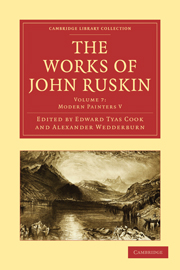Book contents
- Frontmatter
- Contents
- LIST OF ILLUSTRATIONS
- INTRODUCTION TO THIS VOLUME
- BIBLIOGRAPHICAL NOTE
- Modern Painters, Vol. V.
- PREFACE
- PART VI “OF LEAF BEAUTY”
- PART VII “OF CLOUD BEAUTY”
- PART VIII “OF IDEAS OF RELATION:—FIRST, OF INVENTION FORMAL”
- PART IX “OF IDEAS OF RELATION:—SECOND, OF INVENTION SPIRITUAL”
- CHAP. I THE DARK MIRROR
- CHAP. II THE LANCE OF PALLAS
- CHAP. III THE WINGS OF THE LION
- CHAP. IV DÜRER AND SALVATOR
- CHAP. V CLAUDE AND POUSSIN
- CHAP. VI RUBENS AND CUYP
- CHAP. VII OF VULGARITY
- CHAP. VIII WOUVERMANS AND ANGELICO
- CHAP. IX THE TWO BOYHOODS
- CHAP. X THE NEREID'S GUARD
- CHAP. XI THE HESPERID ÆGLÉ
- CHAP. XII PEACE
- EPILOGUE (1888)
- APPENDIX
- Plate section
CHAP. III - THE WINGS OF THE LION
Published online by Cambridge University Press: 07 September 2011
- Frontmatter
- Contents
- LIST OF ILLUSTRATIONS
- INTRODUCTION TO THIS VOLUME
- BIBLIOGRAPHICAL NOTE
- Modern Painters, Vol. V.
- PREFACE
- PART VI “OF LEAF BEAUTY”
- PART VII “OF CLOUD BEAUTY”
- PART VIII “OF IDEAS OF RELATION:—FIRST, OF INVENTION FORMAL”
- PART IX “OF IDEAS OF RELATION:—SECOND, OF INVENTION SPIRITUAL”
- CHAP. I THE DARK MIRROR
- CHAP. II THE LANCE OF PALLAS
- CHAP. III THE WINGS OF THE LION
- CHAP. IV DÜRER AND SALVATOR
- CHAP. V CLAUDE AND POUSSIN
- CHAP. VI RUBENS AND CUYP
- CHAP. VII OF VULGARITY
- CHAP. VIII WOUVERMANS AND ANGELICO
- CHAP. IX THE TWO BOYHOODS
- CHAP. X THE NEREID'S GUARD
- CHAP. XI THE HESPERID ÆGLÉ
- CHAP. XII PEACE
- EPILOGUE (1888)
- APPENDIX
- Plate section
Summary
§ 1. Such being the heroic spirit of Greek religion and art, we may now with ease trace the relations between it and that which animated the Italian, and chiefly the Venetian, schools.
Observe, all the nobleness, as well as the faults, of the Greek art were dependent on its making the most of this present life. It might do so in the Anacreontic temper—Τί ΙΙλειάδεσσι κᾲμοί “What have I to do with the Pleiads?” or in the defiant or the trustful endurance of fate;—but its dominion was in this world.
Florentine art was essentially Christian, ascetic, expectant of a better world, and antagonistic, therefore, to the Greek temper. So that the Greek element, once forced upon it, destroyed it. There was absolute incompatibility between them. Florentine art, also, could not produce landscape. It despised the rock, the tree, the vital air itself, aspiring to breathe empyreal air.
Venetian art began with the same aim and under the same restrictions. Both are healthy in the youth of art. Heavenly aim and severe law for boyhood; earthly work and fair freedom for manhood.
§ 2. The Venetians began, I repeat, with asceticism; always, however, delighting in more massive and deep colour than other religious painters. They are especially fond of saints who have been cardinals, because of their red hats, and they sunburn all their hermits into splendid russet brown.
- Type
- Chapter
- Information
- The Works of John Ruskin , pp. 279 - 299Publisher: Cambridge University PressPrint publication year: 2010First published in: 1903



